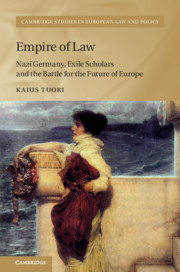Book contents
- Empire of Law
- Cambridge Studies in European Law and Policy
- Empire of Law
- Copyright page
- Dedication
- Contents
- Figures
- Preface
- Abbreviations
- 1 Introduction
- 2 Legal Refugees from Nazi Germany and the Idea of Liberty
- 3 Redefining the Rule of Law, Jurisprudence and the Totalitarian State
- 4 The Long Legal Tradition and the European Heritage in Nazi Germany
- 5 Reconfiguring European Legal Tradition after the War
- 6 The European Narrative and the Tradition of Rights
- 7 Conclusions
- Bibliography
- Index
6 - The European Narrative and the Tradition of Rights
Published online by Cambridge University Press: 23 March 2020
- Empire of Law
- Cambridge Studies in European Law and Policy
- Empire of Law
- Copyright page
- Dedication
- Contents
- Figures
- Preface
- Abbreviations
- 1 Introduction
- 2 Legal Refugees from Nazi Germany and the Idea of Liberty
- 3 Redefining the Rule of Law, Jurisprudence and the Totalitarian State
- 4 The Long Legal Tradition and the European Heritage in Nazi Germany
- 5 Reconfiguring European Legal Tradition after the War
- 6 The European Narrative and the Tradition of Rights
- 7 Conclusions
- Bibliography
- Index
Summary
The sixth chapter approaches the reconfiguring of the legal tradition through the work of Helmut Coing and his idea of the tradition of rights as a jurisprudential construct. This is contextualized through the rise of the rights tradition in human rights scholarship and the central role that human rights came to have in the initial stages of the European project. This emphasis, resulting in the creation of the European Convention of Human Rights, was mirrored by the commitment of the new German state to democracy and rights. The chapter concludes with an analysis of the spread of the European narrative about the role of Roman law and its greatest proponents, among them Reinhard Zimmermann.
Keywords
- Type
- Chapter
- Information
- Empire of LawNazi Germany, Exile Scholars and the Battle for the Future of Europe, pp. 221 - 262Publisher: Cambridge University PressPrint publication year: 2020

